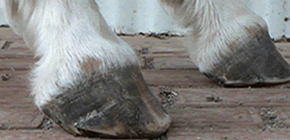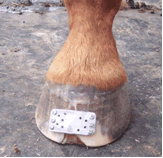Hoof cracks have a reason for existing.
The secret to success with fixing hoof cracks is to treat them as a symptom and therefore address and hopefully remove the underlying cause, which could be one or more of the following:
Over long wall - mechanical forces split the wall, so fixing these cracks is simply a matter of removing the lever forces and keeping the foot maintained. (photos below)

Before<

After 4 months
Seedy toe - this eats a cavity in the inner wall, creating a structural weakness that cracks the outer wall. Such cracks will not grow out until the seedy toe is first removed, thus allowing the cavity to grow out.
Sand cracks - these start off very superficially and travel inwards through to the inner wall and sometimes the sensitive dermal layer; they result from either extreme environmental fluctuations (wet to dry or dry to wet) or too much mechanical stretch being forced onto the outer wall.
Trauma - if a hoof has been torn apart, the leading edges of the remaining wall need to be well rounded off to prevent further damage (in the case of major wall loss, a bar shoe may be needed temporarily to stabilize the remaining wall and protect any exposed corium).<
What about permanent cracks?
If the underlying cause of the crack cannot be removed, it is logical to expect the crack will always be there (this is most often the outcome associated with trauma that dissects the coronary band).
Permanent defects are best managed by maintaining the feet so that minimal weight is borne by the crack - particular attention needs to be paid to medial/lateral balance and keeping the outer wall passive. A well maintained barefoot is the best option.
Some serious cracks may need to be stabilized with a metal plate.
Pics below - old crack invaded by seedy toe. Resected and stabilized by a metal plate. Pic at right the end result.




Seedy toe

Sand cracks

Trauma